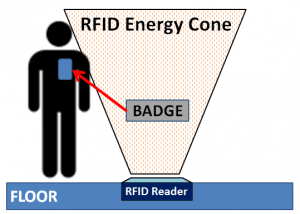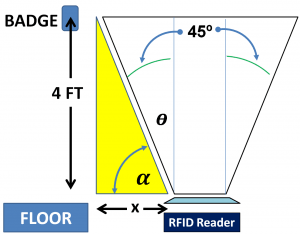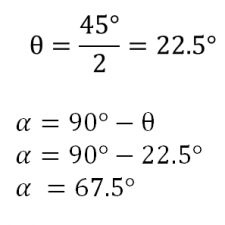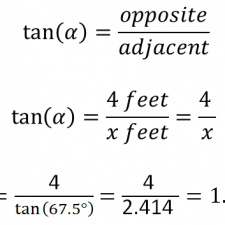
A customer asked if we could use a passive UHF RFID (Ultra-High Frequency Radio Frequency Identification) system to monitor if employees crossed a certain line in their warehouse. Because of the industry they were in, they could be assessed steep fines when unauthorized people entered restricted areas. After hearing about this request from my engineers, I jumped in because it gave me the opportunity to work on some real, honest to goodness, mathematics.
In my former life as a PhD student at UC San Diego, I was privileged to be able to work on math problems every day. However, in my current position as the CEO of Telaeris, the occasions to use higher math are few and far between. But boy – do I ever love math! And because we solved the problem for our customer, you get the solution for free, just by reading.
Looking at our customer’s problem initially, we decided that because of the high ceilings in the warehouse, we would likely have the reader antennas mounted in the floor.
The question we needed to answer was this:
How far away from the line does the RFID reader need to be installed?

We chose wide RFID antennas, to minimize the number of antennas that would be used. Each antenna had beam width of 45 degrees. If employee badges are worn around the neck, the badges should hang about 4 feet above the ground. This is where the math comes in. We need to set up a series of equations to calculate the distance X from the line that the reader has to be installed. The diagram is shown below.

Digging back thirty years to my trigonometry class at La Salle High School in Pasadena with Mr. Uejima, I recalled a couple of facts. Given one side and one angle of a right triangle, it is possible to solve for all other sides or angles.
First, we need to get the angle α. Because α + θ is a right angle (90°) and we know that the full beam width is 45° we can solve for α with the following equations:

Then from the dark recesses of my mind an acronym came forth calling out “TOA….TOA…TOA” – tangent equals opposite over adjacent! With this, I was able to set up the equations to solve directly for the distance X.

Of course, when we use to do this at school, we had trig tables in the back of our math books. Today, I just asked my cell phone “what is the tangent of 67.5 degrees” and was rewarded with the value for my calculations.
The answer for the distance from the line is calculated to be 1.66 feet or 20 inches away from the line. This makes the do not cross zone rather tight and well contained.
I love the fact that with just a little bit of math and common sense, we are able to quickly characterize how a system should theoretically behave. Of course, this doesn’t account for the way passive RFID can reflect and bounce, but some issues can only be solved with testing in the field.
The next time we get into math, I hope to be able to discuss multi-variable optimization of real time location systems… but somehow I think I will have a much smaller audience for that article!

Dave,
I really enjoy your news letter & more importantly for the most part I understand what you are saying. So if you are trying to educate the under educated under achieving you are succeeding. Hope this finds you and your tribe are all well.
Steve